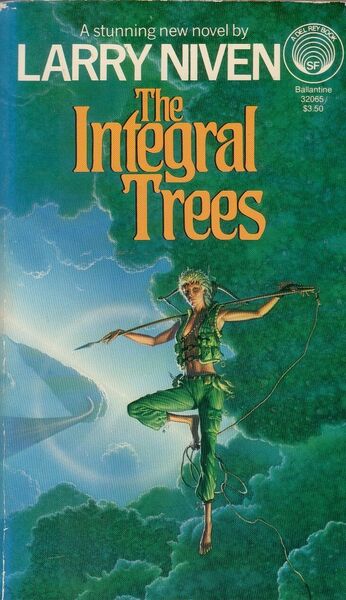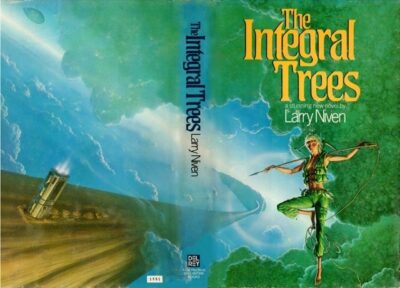Your Sanctuary
The Integral Trees (Integral Trees, volume 1)
By Larry Niven

7 Aug, 2025
1984’s The Integral Trees is the first volume in Larry Niven’s Integral Trees duology. The duology takes place in Niven’s State1 universe.
Five hundred years ago the crew of the Bussard ramjet Discipline mutinied and abandoned the starship. They left to colonize the Smoke Ring, a bizarre environment near Levoy’s Star. Or so emulated human/AI Sharls Davis Kendy believes. He has long since erased the details.
Kendy long ago lost contact with the descendants of the supposed mutineers. Too bad for the Quinn tribe, as they are doomed and could use help.
But first, worldbuilding!
Levoy’s Star (“Voy”2) is an old neutron star, orbited by the former gas giant Goldblatt’s World (“Gold”). Gold’s orbit is close enough to the neutron star that the tidal effects continually strip gases off Gold. The gas has, over hundreds of millions of years, formed a torus, the Smoke Ring, around Voy. The Smoke Ring is about 160,000 kilometers in circumference.
What caught the attention of the Discipline’s crew half a millennium ago is that the center, densest region of the Smoke Ring is filled with life. Moreover, the Smoke Ring gases are human-breathable. Therefore, the Smoke Ring represents a vast living space, particularly on the hundred kilometer-long “integral trees” (named for their distinctive shape) that orbit within the Smoke Ring.
Regrettably for the Quinn tribe, their tree passed too close to Gold. Its new orbit passes through the outer, lower pressure region of the Smoke Ring habitable zone. The immediate effect is lower pressure and an on-going drought. Longer-term, who can say?
Out of an excess of prudence, Quinn’s Chairman selects a crack team of people he considers expendable, potential threats to his rule, or whom he just doesn’t like. The nine selected are the Grad, Gavving, Merril, Jiovan, Glory, Alfin, Clave, and Clave’s young twin wives, Jayan and Jinny. None of them will ever return home.
One of the first discoveries the explorers make: the other end of the Quinn tree is home to the Quinn-Dalton tribe, who are actively hostile (due to events which the Quinns have long forgotten). Another, more important, discovery, is that trees deprived of water rot from their center point. When the tree breaks, as the Quinn tree does, one part falls farther from Voy and the other orbits closer.
Not all of the expedition dies in the fight with the Quinn-Dalton tribe or the great disaster that interrupts the battle. The survivors manage to find their way to another tree. There, they make an even more momentous discovery:
Some of the other communities in the Smoke Ring aren’t just hostile. They are predatory.
~oOo~
I was today years old when I discovered that Del Rey had published an omnibus that contains both the novel The Integral Trees and its sequel, The Smoke Ring. The omnibus shares a title with The Integral Trees, which is the sort of bold decision that never causes avoidable confusion3. Luckily for me, the person who commissioned the review meant the novel.
This is a hard science fiction novel. Hard SF is defined as:
SF that provides enough technical detail that the reader can be certain that various mechanisms and events couldn’t work the way the author has them working.
The setting is very cool, but it doesn’t make much sense. Don’t think about details such as “would gas really work as the plot requires?” It will just spoil the fun. Inventing cool settings that don’t stand up to a moment’s consideration is Niven’s strength. Here, he delivers.
Niven has never been known for his prose or characters. Here too he delivers: the characters are basically interchangeable, as least as far as dialogue goes. Well, the ones who die are on the whole less active than the ones who survive, but good luck working out who is who just from their speech.
While The Integral Trees features many events, the novel has even less plot than Ringworld, which barely had any plot at all. The Integral also lacks a convincing resolution, the plot not so much concluding as stopping. Back in 1984, it felt like half a novel, and not such an interesting half that I ever got around to picking up the sequel, The Smoke Ring. It wasn’t that I actively disliked the novel so much as it was kind of boring and I had better things to do with my time and money.
Readers and colleagues4 had a far more positive reaction to The Integral Trees than I did. The Integral Trees was a Hugo finalist5, placing6 5th, and a Nebula finalist7 as well, finishing 4th.
Still, the novel is not entirely without points of interest. For example, the characters take a firm antislavery, anti-rape stance. At least, the ones who are enslaved and raped do. The slavers seem pretty keen on the arrangement. I am not entirely certain just how a white conservative like Niven would have encountered the notion that slavery isn’t fun for the slaves or that on the whole, women prefer not to be raped. Not from Pournelle, I bet. Conservatives need not fret too much: forced marriage is still A‑OK.
The true high point is Michael Whelan’s wraparound cover.

Whelan covers always make clear that he reads the books for which his art is commissioned. Alas, even a Whelan cover wasn’t enough to entice me to read the sequel.
The Integral Trees is available here (Del Rey), here (Barnes & Noble), here (Bookshop US), here (Chapters-Indigo), and here (Words Worth Books). That’s probably the omnibus, not the first half of the duology.
I did not find The Integral Trees at Bookshop UK.
1: USA delenda, absorbed into the State.
2: I suspect Niven got tired of typing Levoy’s Star and Goldblatt’s World over and over.
3: Mutters about the Don’t Bite the Sun omnibus titles.
4: Possibly reviewers as well, although I won’t hunt down reviews to check.
5: Not quite the final time Niven would appear on a Hugo ballot, but close. Footfall was nominated in 1986, and “The Return of William Proxmire” in 1990 and that was that for the Hugo where Niven was concerned. Mind you, James Joyce wasn’t nominated even once so perhaps one should not read too much into a lack of Hugo nominations.
6: Adding a superscripted 6 to 5th looked weird so I moved the 6 a word earlier.
The finalists were by Neuromancer by William Gibson (which won), followed by (in order) Emergence by David R. Palmer, The Peace War by Vernor Vinge, Job: A Comedy of Justice by Robert A. Heinlein, and finally, The Integral Trees by Larry Niven.
Am I obligated to review the one book from the set that I have not yet reviewed? I’ve read it and I do own it.
7: The finalists were Neuromancer by William Gibson (which won), followed by Frontera by Lewis Shiner, Job: A Comedy of Justice by Robert A. Heinlein, The Integral Trees by Larry Niven, The Man Who Melted by Jack Dann, and The Wild Shore by Kim Stanley Robinson.
